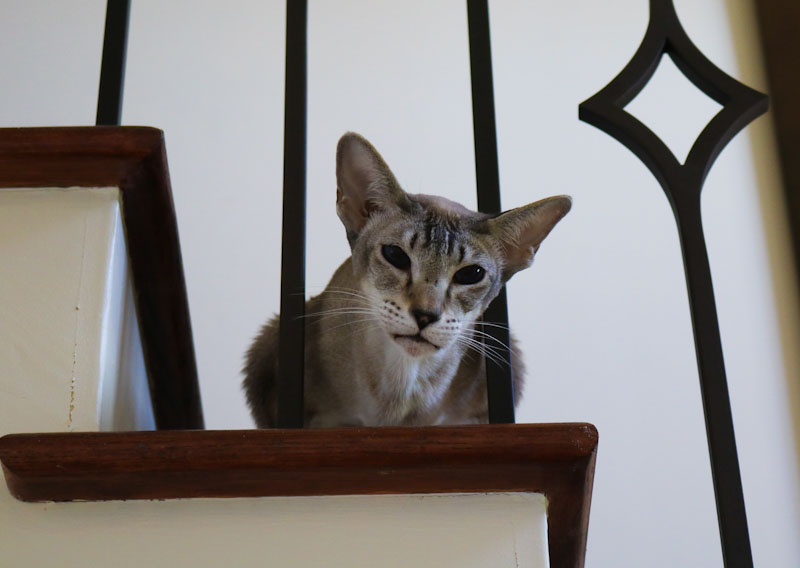Throughout our twenty some years running a rescue, the two issues that repeatedly came up as causing an issue within the household were litterbox misbehavior and aggression, or biting. We’ve spent some time talking about the litterbox https://siriouslysiri.com/2021/12/27/out-of-the-box-experiences-part-1/ and https://siriouslysiri.com/2022/01/04/out-of-the-box-experiences-part-2/; let’s look at some of the reasons for biting behaviors.
While there are some cats who have learned, overtime, that humans are awful and scary and therefore may be proactively aggressive with you, typically you see a cat bite or nip in reaction to something you are doing, or not doing – bringing some of the onus back to the owner.
Some of the more common reasons cats nip:
- We have taught them to do this by our own behavior
- They are frightened
- They are seeking attention, albeit inappropriately
- They are overstimulated
- They are vying for Top Cat Position
- They are declawed*
As a kitten, many people (and sorry, guys, but a heavy portion of the blame may fall on you) have actually taught the cat to pounce on hands. Think about the all-too-common scenarios – the kitten is on the bed, and you are wiggling your fingers (or toes) under the sheet, encouraging the cat to pounce. Alternatively, there is no sheet or blanket, and you are using your fingers to tempt the kitten to play. A pouncing kitten is often followed by a full hand-on grab around the belly, perhaps rocking or jiggling the kitten back and forth as a tease. While this behavior may seem like harmless fun, and yes, many of us did it for years, what we are teaching the cat via this behavior is that hands and fingers are toys. When that kitten goes from a 2 pound jumping bean to 10 pounds of solid muscle, it’s no longer funny – yet too often, we were the ones who taught the cat to behave this way. From the beginning, never ever use your hands as play toys – always use a cat toy as you encourage the very normal kitten behaviors of pouncing, chewing and ‘bunny kicking.’ Hands should be kept for soft movements, such as petting.
Cats who respond with biting behaviors when frightened, are, well, frightened of something, and often that may be you. It’s pretty simple. Stop whatever you are doing that is triggering the fear. Along these lines, realize that picking up and cuddling a cat is a human need – it’s not necessarily something the cat wants until they are comfortable with you, and maybe not even then. Just like you don’t force yourself on another person, do not force yourself on the cat until the cat is ready. And yes, some cats may never be ready for the level of interaction you are attempting. (One of our cats has been with us in a quiet loving household for ten years, and we still can’t pick her up).
As far as seeking attention, cats are not much different than children in that if they feel lacking in the attention department, they are going to seek you out, even if the interaction results in negative attention. While there are some cats who may by nature be standoffish and want to be left alone, cats in general are social creatures, and your typical house cat will, at some point, appreciate your attention – whether it’s playing with them, petting them, or just feeding them. If you continue to ignore them, some cats may revert to nipping or grabbing at your hands in an attempt to get you to recognize their need for interaction. While we will discuss ways to curb this behavior in a separate post, keep in mind that if you have taken on the responsibility of a pet, that responsibility includes paying it some attention, regardless of how busy your day was or how exhausted you may feel. This could be petting, if that’s what the cat wants, or it could be playing (feather wands are great for this).
Overstimulation can happen as a result of how you are interacting with the cat; it may also happen as a result of something external that is in the environment. If you are in the middle of an intense brushing session, for example, you may notice your cat’s tail begin to twitch, or the skin to ripple – and because cats can’t talk to you and say ‘ouch, you’re too rough’ or ‘that’s enough thank you’ they may overreact if you continue the behavior. Just as you might ask someone to stop if they were getting too intense with a neck massage, your cat may simply be asking you to cool it. Pay attention to those body signs.
There may be external forces at work as well that are causing overstimulation. If you’ve ever watched your cat at the window eyeing the birds, or perhaps another cat that’s outside, you are likely to notice some tail twitching and vocalizations of some sort. Should you choose this inopportune time to focus on petting your cat, or even just picking it up, you may find you get a smack or a nip. External overstimulation, or redirected aggression, requires you to pay attention to the environment and to selectively choose the times you are going to interact with your cat. It’s a two way street – when you want to give attention, your cat should indicate they are ready for your interaction, either by seeking you out or by demonstrating positive responses when you begin to touch them.
Finally, nipping can occur when the cat is challenging you for Top Cat. This is a bit more difficult to address and we see it a lot when a very smart cat is owned by a very ‘gentle-natured’ person:
Cats tend to live in hieararchies. Whether it be lions in the wild or multiple domestic cats in the home, there is almost always a Top Cat. Sometimes it’s obvious which one is dominant (they usually eat first, they are never usurped for the best sleeping spot, etc.), sometimes it’s very subtle and hard to tell. When you have just one cat and one owner, it’s clearly the owner who is supposed to be dominant. However, when the owner a) caters to every whim of the cat (you want to get up at 4am and play? Sure! You want to have a snack at midnight? Absolutely!) or when the owner is intimidated by the cat, the cat may take that as an indication that the position of Top Cat is available. This results in the cat expecting you to bow to their every desire, and if you don’t, reaping the consequences. If this is you, giving in to excessive whims of your cat, you may need to work to adjust that. You are the boss, you choose the rules. Sure, we accommodate and spoil our cats in many ways, but you can’t sacrifice your health and welfare to do so. And if you’re intimidated by your cat, (and I’m surprised at the number of people who are), you need to work to get over that, taking up the lead position in the relationship. You are bigger, stronger, and in charge, so while it’s important you are compassionate, kind and sympathetic to the cat’s needs, you can’t be frightened of the cat, or the relationship is not going to work.
*Finally, we should mention cats that have been declawed. In rescue and shelter situations, where cats have been traumatized at some point for some reason (abuse, abandonment, etc.) and then find themselves in a situation where they feel threatened, declawed cats are very likely to use their teeth as a defense weapon. Makes total sense when you realize that they no longer have their claws, so the warning swat no longer holds any weight. We won’t talk about the cons of declawing in this post; suffice it to say it pays to be aware that those cats who have been declawed may well become biters.
In Part 2, we’ll talk about different ways to address nipping and biting behaviors, so stay tuned. (If you enjoy these posts, please consider subscribing to the blog, and thank you!)

